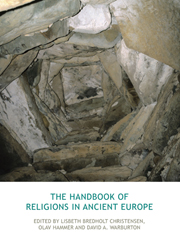Book contents
- Frontmatter
- Contents
- A note on Greek and Latin sources
- Abbreviations and short titles
- 1 Introduction
- PART I PREHISTORIC RELIGIONS
- PART II ANCIENT EUROPE IN THE HISTORICAL PERIOD
- 12 Minoan and Mycenaean religion
- 13 Etruscan religion
- 14 The religions of the Iberian Peninsula
- 15 Italic religion
- 16 Roman religion
- 17 Ancient Greek religion
- 18 The Graeco-Roman cult of Isis
- 19 The cult of Mithras
- 20 Religious Platonism: philosophy and religion in the Platonic tradition
- 21 Insular Celtic religion
- 22 Continental Germanic religion
- 23 Pre-Christian Anglo-Saxon religion
- 24 Old Norse religion
- 25 Slavic religion
- 26 Baltic religion
- 27 Religion in prehistoric Finland
- 28 Sami religion
- Timeline of key dates
- Contributors
- References
- Index
27 - Religion in prehistoric Finland
from PART II - ANCIENT EUROPE IN THE HISTORICAL PERIOD
- Frontmatter
- Contents
- A note on Greek and Latin sources
- Abbreviations and short titles
- 1 Introduction
- PART I PREHISTORIC RELIGIONS
- PART II ANCIENT EUROPE IN THE HISTORICAL PERIOD
- 12 Minoan and Mycenaean religion
- 13 Etruscan religion
- 14 The religions of the Iberian Peninsula
- 15 Italic religion
- 16 Roman religion
- 17 Ancient Greek religion
- 18 The Graeco-Roman cult of Isis
- 19 The cult of Mithras
- 20 Religious Platonism: philosophy and religion in the Platonic tradition
- 21 Insular Celtic religion
- 22 Continental Germanic religion
- 23 Pre-Christian Anglo-Saxon religion
- 24 Old Norse religion
- 25 Slavic religion
- 26 Baltic religion
- 27 Religion in prehistoric Finland
- 28 Sami religion
- Timeline of key dates
- Contributors
- References
- Index
Summary
LOCATING FINLAND IN PREHISTORIC EUROPE
In terms of climate, geography, culture and language, Finland is situated on the polar front. Linguistic elements and cultural patterns from diverse geographical areas have met on the present-day Finnish soil and have shaped the conditions of life ever since the prehistoric era, which extends from 9000 BCE until 1200 CE when Christianity was introduced to Finland. According to the latest archaeological findings, the oldest dwelling site is situated at Orimattila in southern Finland. The finds of the Myllykoski site consist of quartz and burnt bone, and it is located close to another significant Mesolithic settlement in Ristola in Lahti (southern Finland). According to the Finnish archaeologist Hannu Takala, Ristola is a multi-period site that dates back to 8170–7880 BCE. Almost 1600 shards of Corded Ware pottery excavated there date to many millennia after its first settlement. A third site worthy of mention is located at Kuurmanpohja in Joutseno, south-eastern Finland; the excavation finds include flint artifacts and an item comparable to arrowheads of the Sigir type dated to 8710–8490 BCE (Takala 2009: 31).
Consensus prevails among archaeologists (see Takala 2009) that colonization spread by moving to the north-west and into northern Finland. Human settlement has been continuous throughout the whole postglacial period. There is no way of knowing the ethnicity and language of these nomadic peoples, not to mention the cosmology, religion and world-view they adhered to.
- Type
- Chapter
- Information
- The Handbook of Religions in Ancient Europe , pp. 372 - 391Publisher: Acumen PublishingPrint publication year: 2013



